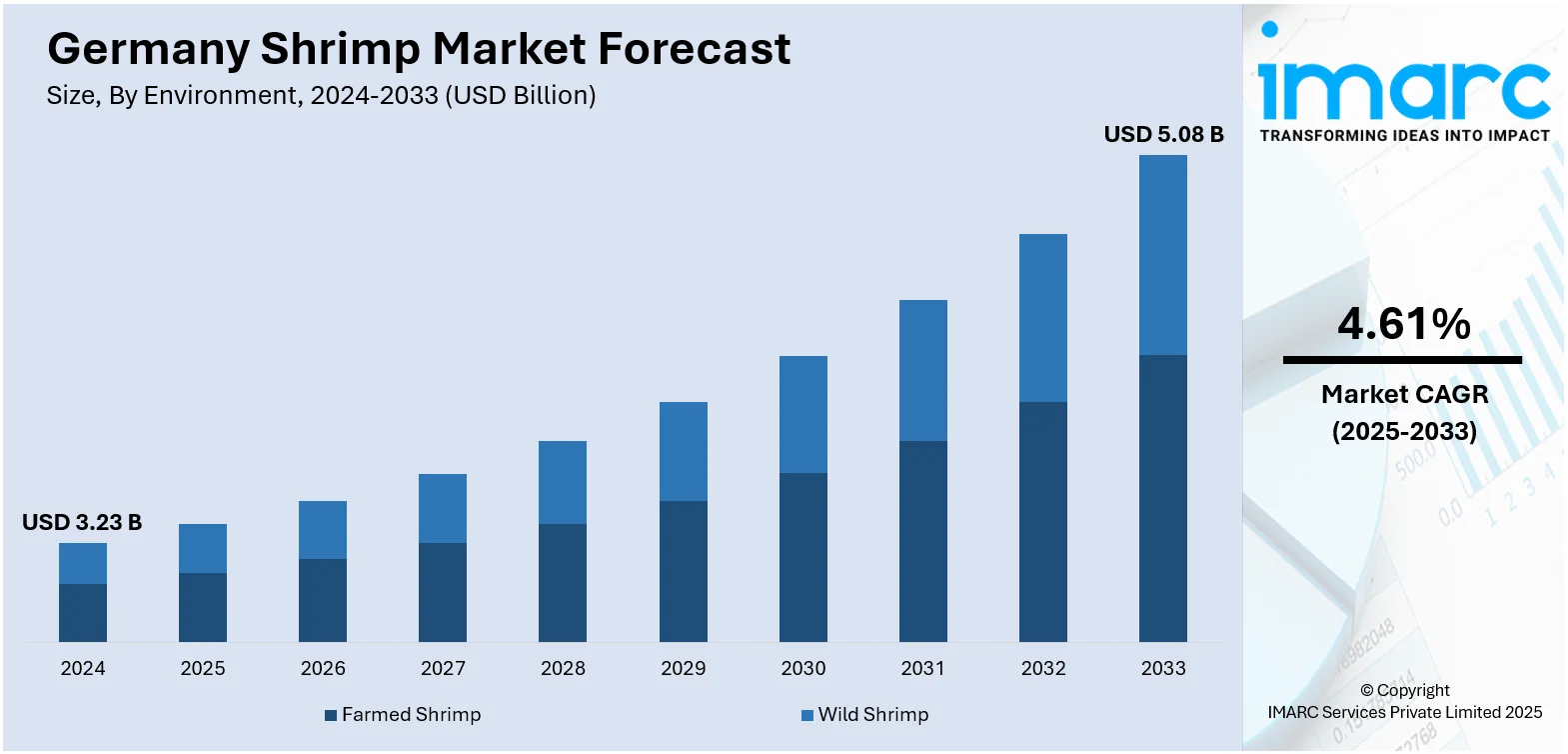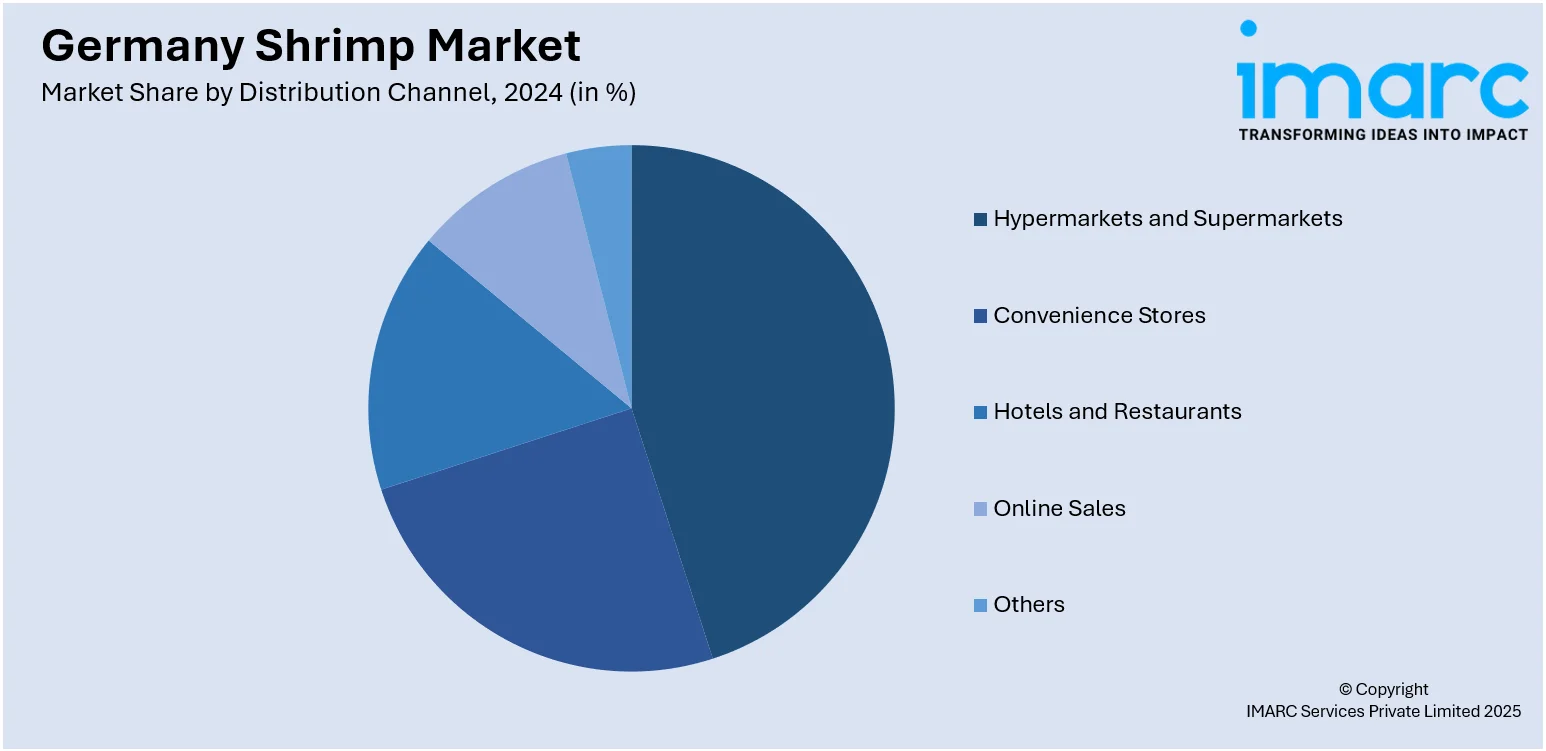
Germany Shrimp Market Size, Share, Trends and Forecast by Environment, Species, Shrimp Size, Distribution Channel, and Region, 2025-2033
Germany Shrimp Market Overview:
The Germany shrimp market size reached USD 3.23 Billion in 2024. The market is projected to reach USD 5.08 Billion by 2033, exhibiting a growth rate (CAGR) of 4.61% during 2025-2033. The market is expanding, driven by increasing consumer demand for healthy and sustainable seafood options. Growing interest in premium and ethically sourced shrimp, along with the rising popularity of shrimp dishes in foodservice, is enhancing Germany shrimp market share across both retail and dining sectors.
|
Report Attribute
|
Key Statistics
|
|---|---|
|
Base Year
|
2024 |
|
Forecast Years
|
2025-2033
|
|
Historical Years
|
2019-2024
|
| Market Size in 2024 | USD 3.23 Billion |
| Market Forecast in 2033 | USD 5.08 Billion |
| Market Growth Rate 2025-2033 | 4.61% |
Germany Shrimp Market Trends:
Surge in Germany Shrimp Industry Demand
Shrimp market has recorded a consistent growth in demand, which has been fueled by consumer tastes and lifestyle changes. Owing to increased interest in healthy diets, shrimp has been a favorite owing to its nutritional value, such as high protein and low fat content. The increase in seafood eating trends, especially in city centers, has also augmented the market growth. Germany has experienced growth in recent years toward premium seafood offerings, with buyers demanding fresh, sustainable, and high-quality products. Germany shrimp market is also driven by the rising number of foodservice outlets that provide shrimp-based meals. Fine dining and fast-casual restaurants are including shrimp on their menus to cater to the varied tastes of the consumers. The increasing popularity of e-commerce websites selling fresh and frozen seafood has made shrimp more convenient for consumption by households, and hence retail and online demand has increased. Also, the trade agreements with other countries and better distribution channels have enabled Germany to import shrimp in an effective manner, further increasing market availability. With increasing consumer demand, sustainably and ethically farmed shrimp is emerging as a central concern, part of a wider movement towards environmental sustainability in food production.

To get more information on this market, Request Sample
Impact of Sustainability on Shrimp Supply
Sustainability is emerging as a significant factor influencing the shrimp market in Germany, shaping both consumer choices and supplier practices. With increasing awareness about overfishing, environmental degradation, and unethical farming practices, consumers are more conscientious about the origin of their seafood. As a result, there is a noticeable demand for sustainably farmed shrimp, with certifications like ASC (Aquaculture Stewardship Council) becoming highly valued in the marketplace. The growing emphasis on sustainability has driven suppliers to adopt eco-friendly practices, both in shrimp farming and in sourcing from wild fisheries. Several German retailers and foodservice businesses are now prioritizing shrimp that are certified by reputable sustainability programs, addressing consumer concerns about environmental impact. Moreover, collaborations between the German government and international seafood organizations have aimed at improving the traceability and transparency of the shrimp supply chain, ensuring that sustainable practices are followed. As consumer preferences shift towards eco-conscious purchasing decisions, the demand for certified, responsibly farmed shrimp is expected to further rise, ensuring that sustainability continues to shape the future of the Germany shrimp market growth.
Germany Shrimp Market Segmentation:
IMARC Group provides an analysis of the key trends in each segment of the market, along with forecasts at the country and regional level for 2025-2033. Our report has categorized the market based on environment, species, shrimp size, and distribution channel.
Environment Insights:
- Farmed Shrimp
- Wild Shrimp
The report has provided a detailed breakup and analysis of the market based on the environment. This includes farmed shrimp and wild shrimp.
Species Insights:
- Penaeus Vannamei
- Penaeus Monodon
- Macrobrachium Rosenbergii
- Others
The report has provided a detailed breakup and analysis of the market based on the species. This includes penaeus vannamei, penaeus monodon, macrobrachium rosenbergii, and others.
Shrimp Size Insights:
- <21
- 21-25
- 26-30
- 31-40
- 41-50
- 51-60
- 61-70
- >70
The report has provided a detailed breakup and analysis of the market based on the shrimp size. This includes <21, 21-25, 26-30, 31-40, 41-50, 51-60, 61-70, and >70.
Distribution Channel Insights:

- Hypermarkets and Supermarkets
- Convenience Stores
- Hotels and Restaurants
- Online Sales
- Others
A detailed breakup and analysis of the market based on the distribution channel have also been provided in the report. This includes hypermarkets and supermarkets, convenience stores, hotels and restaurants, online sales, and others.
Regional Insights:
- Western Germany
- Southern Germany
- Eastern Germany
- Northern Germany
The report has also provided a comprehensive analysis of all the major regional markets, which include Western Germany, Southern Germany, Eastern Germany, and Northern Germany.
Competitive Landscape:
The market research report has also provided a comprehensive analysis of the competitive landscape. Competitive analysis such as market structure, key player positioning, top winning strategies, competitive dashboard, and company evaluation quadrant has been covered in the report. Also, detailed profiles of all major companies have been provided.
Germany Shrimp Market Recent News:
- April 2025: Pacific Seafood opened its first European office in Hamburg, Germany, to support its "Mission 31" initiative. This expansion strengthened its supply chain for coldwater shrimp, offering direct access to high-quality, sustainable shrimp products. The move is expected to enhance market presence and growth in Europe.
- November 2024: WEDA Dammann & Westerkamp GmbH partnered with Damm Aquakultur to advance shrimp farming technology in Germany. Their collaboration focused on sustainable husbandry, feeding systems, and water treatment. This development is expected to enhance production efficiency and promote sustainable shrimp farming, ultimately benefiting the market.
Germany Shrimp Market Report Coverage:
| Report Features | Details |
|---|---|
| Base Year of the Analysis | 2024 |
| Historical Period | 2019-2024 |
| Forecast Period | 2025-2033 |
| Units | Billion USD |
| Scope of the Report | Exploration of Historical Trends and Market Outlook, Industry Catalysts and Challenges, Segment-Wise Historical and Future Market Assessment:
|
| Environments Covered | Farmed Shrimp, Wild Shrimp |
| Species Covered | Penaeus Vannamei, Penaeus Monodon, Macrobrachium Rosenbergii, Others |
| Shrimp Sizes Covered | <21, 21-25, 26-30, 31-40, 41-50, 51-60, 61-70, >70 |
| Distribution Channels Covered | Hypermarkets and Supermarkets, Convenience Stores, Hotels and Restaurants, Online Sales, Others |
| Regions Covered | Western Germany, Southern Germany, Eastern Germany, Northern Germany |
| Customization Scope | 10% Free Customization |
| Post-Sale Analyst Support | 10-12 Weeks |
| Delivery Format | PDF and Excel through Email (We can also provide the editable version of the report in PPT/Word format on special request) |
Key Questions Answered in This Report:
- How has the Germany shrimp market performed so far and how will it perform in the coming years?
- What is the breakup of the Germany shrimp market on the basis of environment?
- What is the breakup of the Germany shrimp market on the basis of species?
- What is the breakup of the Germany shrimp market on the basis of shrimp size?
- What is the breakup of the Germany shrimp market on the basis of distribution channel?
- What is the breakup of the Germany shrimp market on the basis of region?
- What are the various stages in the value chain of the Germany shrimp market?
- What are the key driving factors and challenges in the Germany shrimp market?
- What is the structure of the Germany shrimp market and who are the key players?
- What is the degree of competition in the Germany shrimp market?
Key Benefits for Stakeholders:
- IMARC’s industry report offers a comprehensive quantitative analysis of various market segments, historical and current market trends, market forecasts, and dynamics of the Germany shrimp market from 2019-2033.
- The research report provides the latest information on the market drivers, challenges, and opportunities in the Germany shrimp market.
- Porter's Five Forces analysis assists stakeholders in assessing the impact of new entrants, competitive rivalry, supplier power, buyer power, and the threat of substitution. It helps stakeholders to analyze the level of competition within the Germany shrimp industry and its attractiveness.
- Competitive landscape allows stakeholders to understand their competitive environment and provides an insight into the current positions of key players in the market.
Need more help?
- Speak to our experienced analysts for insights on the current market scenarios.
- Include additional segments and countries to customize the report as per your requirement.
- Gain an unparalleled competitive advantage in your domain by understanding how to utilize the report and positively impacting your operations and revenue.
- For further assistance, please connect with our analysts.
 Request Customization
Request Customization
 Speak to an Analyst
Speak to an Analyst
 Request Brochure
Request Brochure
 Inquire Before Buying
Inquire Before Buying




.webp)




.webp)












